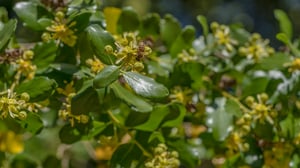The bark of the Quillaja Saponaria tree contains substances (saponins) used as ‘adjuvants’ in the Covid vaccine produced by Novavax and by other companies. However, excess demand may cause problems.
Saponins are found in a special chemical structure in the bark of a tree in the Chilean forest (the Quillaja saponaria, locally known as the Quillay). These substances are in high demand amongst pharmaceutical companies because they work as ‘adjuvants’ in certain types of drugs and animal feed, and are used in both the food and mining industries.
Saponins are already in great demand all over the world and have become an ingredient in a new Covid vaccine developed by the U.S. company Novavax, which is in an advanced testing phase. Huge numbers of doses are destined to be produced when it is approved by international health authorities.
But will there be enough saponins to meet the demand, including vaccines? There is no reliable data on how many Quillaja saponaria trees remain in Chile and so it is extremely difficult to calculate how long supplies will last. However, almost all experts agree that companies using Quillaja saponaria extracts will soon have to find alternative, laboratory-manufactured solutions, which are not that easy.
Boosting the immune system
What are adjuvants? They are substances that render (for unknown reasons) the immune system’s response stronger to vaccines. There are three main types: aluminium salts (wrongly accused of being detrimental to health by anti-vaxxers), squalene (extracted from shark liver and so also in short supply) and certain types of saponins, like QS-21 obtained from the bark of Quillaja saponaria.
Only a very small number of adjuvants are approved by the U.S. Food and Drug Administration due to the potential health risks of these substances.
So why does the Novavax vaccine need saponins? This drug is different from mRNA vaccines (e.g. Pfizer and Moderna) and from viral vector vaccines (AstraZeneca and Johnson & Johnson), and, unlike those of its competitors, involves the coronavirus Spike protein being administered directly into the recipient’s body. By contrast, other vaccines encourage the body’s cells to produce the protein. However, in order to work, the Novavax Spike protein has to be bound to saponins, whose role is to stimulate immune response. The combination of virus proteins and adjuvant substances trigger the creation of antibodies and other reactions in the organism’s defence system. This kind of vaccine is known as a recombinant protein vaccine.
As Novavax plans to produce billions of vaccine doses in the next two years and each will contain around 1 mg of saponin extracted from Quillaja saponaria, saponin gatherers and sellers will find it hard to meet demand, to say the least. Furthermore, another SARS-CoV-2 vaccine developed by GlaxoSmithKline uses saponin, in addition to those that already use them and if this were to go into production there would definitely be a supply crisis.
Excessive exploitation
Many problems are due to the fact that Quillaja saponaria is still largely grown using tradition methods and the leading company in the sector, Desert King International, purchases the bark extract from which saponins are obtained from small local growers. QS-21saponins are also only found in Quillaja saponaria trees that are more than 10 years old and this explains its sky-high price: 1 gram costs over 100,000 dollars.
Profits and growing demand have caused real disasters. To increase yields, many growers have destroyed plants, extracted too much bark and even damaged Quillaja saponaria trees in forests, discovered by using drones.
Faced with this critical situation, described a year ago by U.S. magazine The Atlantic in an in-depth article entitled “The Tree That Could Help Stop the Pandemic”, and as now reported by Reuters News Agency, the Chilean government has intervened with stricter laws. Government bodies have also begun to provide seeds for landowners, encouraging them to plant new trees to replace those lost, as has Desert King International, which ensured Novavax it could supply 700 kg of saponin in 2020, and three times more the following year.
A Japanese success story
It is obvious, however that alternative solutions are needed, also because growing trees requires large amounts of fertiliser and even larger supplies of water, which is unsustainable in the long term. Some companies, like the U.S. Agenus, are trying to optimise cultivation and harvest, while others, like Botanical Solutions, have increased their efforts into developing saponins in laboratories.
Until now it has been virtually impossible to synthesise saponins, due to the complex reactions involved, not all of which are entirely known. However, in recent months a group of Japanese chemists from Osaka University has managed the impossible. The group understood the importance of an enzyme that, until that moment, had not been given a great deal of consideration, and managed to produce saponins in three types of liquorice from a strain of bread yeast. These, in turn, have interesting pharmaceutical properties (many types of plants produce saponins but each one has different characteristics).
Their work, published in the scientific journal Nature Communications, was an important turning point and it is now hoped that the methods used by the Japanese researchers can finally lead to a wholly synthetic production of the saponins used in vaccines.

